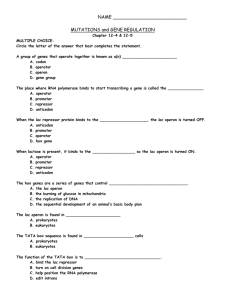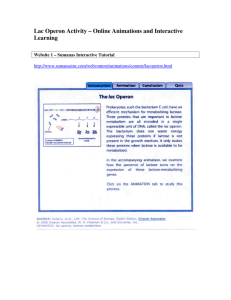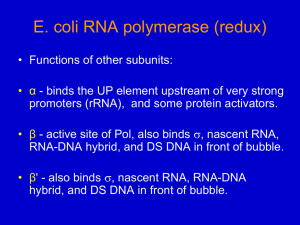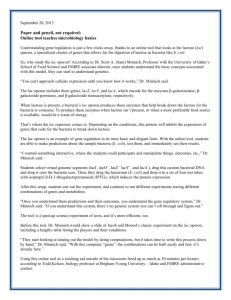“Gene Regulation in Prokaryotes”
advertisement
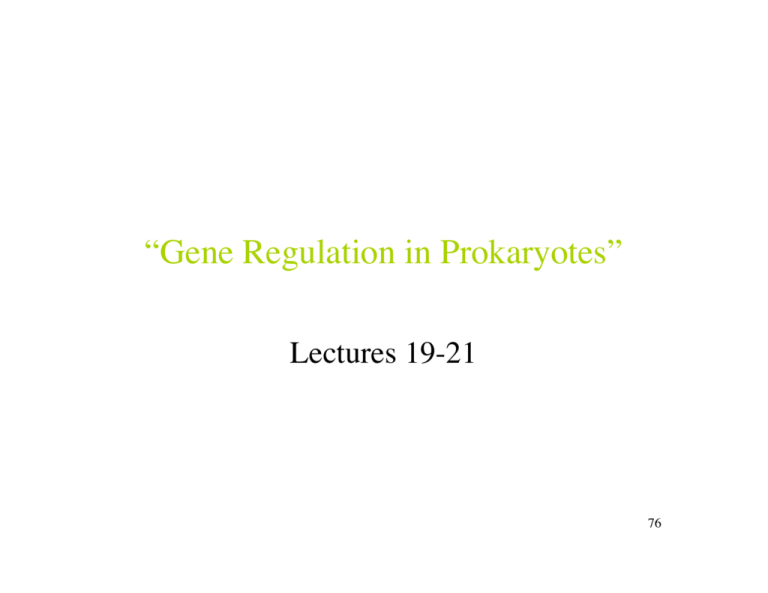
“Gene Regulation in Prokaryotes” Lectures 19-21 76 III. Gene Regulation Questions • How to make different proteins at different times? • How to make different cells that do different things? • How to make different structures from a single egg? • And, how to make different species with similar sets of genes 77 The answers to each of these questions are all founded on the concept of “genetic switches” 78 Approaches 1. Genetics Find mutants for: 2. a) Structural proteins that carry out functions b) Regulatory proteins that control activity of structural genes c) Regulatory elements that act in cis to control gene expression Molecular Biology a) Identify and isolate genes b) Determine how they are regulated c) Determine how their protein products act. 79 Control of Gene Expression in Bacteria and their Viruses I. Physiological Mechanisms 1. 2. 3. 4. The lac operon (genetics) Promoters and repressors Other operons Simple life cycles 80 Physiology • Cells should make the needed proteins at the right time • Do not waste energy In Bacteria : often involves nutrient utilization pathway In Eukaryotes: may involve the generation of specific proteins in specific types of cells The First Model: Lactose utilization in E. coli: B-galactosidase lactose galactose + glucose 2 (a disaccharide) H0 (energy) 81 Adaptation and Induction The presence of substrate, lactose, caused the appearance of enzyme, B-galactosidase. Was this induction an "adaptation" of the enzyme to substrate just as the bacterium "adapts" to environment? Induction lac mRNA B-galactosidease (lacZ) Level Permease (lacY) lactose added 5 lactose 10 removed 82 B-galactosidase (and permease) are inducible 1. In absence of lactose In presence of lactose 1-2 molecues/cell 100,000 molecules/cell 2. Synthesized nearly simultaneously and only after lac mRNA becomes detectable. 3. Lactose (and analogs) is inducer How does a cell "KNOW" what to make? [The great Lysenko vs. Monod-Jacob divide] (Instructive) (Selective) Monod, Jacob, Lwoff sought to explain induction GENETICALLY. 83 The lac operon of E. coli. 84 Key Approach: Mutants and Merozygotes Mutants To Define Key Genetic Elements To Map Them in Relation to Each Other Types of Mutants: lac Z - defective enzyme (B-galactosidase) lac Y - defective permease (trans) lac I - make enzyme continuously (cis) lac 0c - make enzyme continuously "Constitutive" 85 Merozygotes (Partial Diploids) - To test gene functions in cis/trans Note Gene Order NOTE: All lac Genes Map Very Close Together on Chromosome 86 Mutations that abolished enzyme activity were likely to be structural (in the enzyme). Mutations that resulted in altered inducibility (e.g. constitutive) are regulatory and of 2 types: iOc trans-acting cis-dominant Oc - affects expression only on same chromosome or episome (DNA) i- - is recessive to i+ , i+ will act on other chromosomes So, if a merozygote is: i+/ i- it is inducible Oc/O+ it is constitutive Using merozygotes, all sorts of cis, trans combinations could be generated and enzyme production measured. 87 Some Genotypes F' lacI- lacZ+ lacI+ lacZ+ lacOc lacZ+ lacOc lacZlacOc lacZ+ lacIlacZ+ / / / / / / Dipoid Phenotype Chromosome lacI+ lacZ+ lacIlacZ+ lacIlacZ+ lacO+ lacZ+ lacO+ lacZlacIlacZ+ Inducible Inducible Constitutive Inducible Constitutive Constitutive The Operon Model 1. Structural genes: lac Z, Y, A (transport & metabolism) Regulatory elements: the lac I gene- repressor the lac O operator the lac P promoter 2. lac Z, Y, A in a single mRNA - polycistronic 3, Promoter is adjacent to operator (lac P- - no mRNA) 4. lac I protein binds to operator - represses transcription 5. Inducers, e.g. Lactose, bind to and inactivate repressor 88 The lac Operon 89 The lac Operon 90 Operons General Theme: A metabolite controls the expression of a battery of genes that have evolved to utilize it (CATABOLISM) Other Examples: trp - tryptophan biosynthesis ara - arabinose utilization his - histidine biosynthesis Think About: Genetic logic of negative or positive control i. e. repression & activation 91 Operator mutations act in cis 92 Repressor is trans-acting 93 Repressors that cannot bind lactose are “super-repressors” 94 Negative Control of the lac Operon by the lacI Repressor lac repressor is allosteric: allosteric it has two different conformations 1. In presence of inducer, it does not bind DNA 2. In absence of inducer, it binds strongly to lac operator DNA lac I mutations: lac I- - no repressor function - constitutive lac Is - superrepressor - not inducible What about lac Oc? Operator mutations that won't be recognized by repressor protein. Sequence of operator matters Repressor is sequence - specific 95 The DNA Base Sequence of the Operator 96 Positive Control of the lac Operon: CAP and Catabolite Repression Glucose indirectly inhibits lac expression glucose lac If glucose is high cAMP is low low cAMP is high Remember lactose lacZ galactose + glucose If lactose & glucose are present - no lacZ is made until glucose is depleted. How? High cAMP is necessary for activation of lac operon. cAMP is bound by CAP (catabolite activator protein) cAMP-CAP binds to distal part of promoter and facilitates transcription 97 Glucose levels control the lac operon 98 CAP, RNA POLYMERASE AND REPRESSOR BINDING SITES 99 The "Logic" of Operon Control and Resource Utilization • Glucose is normal energy and carbon source. • Cell has "back-up" system to use lactose (lac). • Even if lactose is present, it won't bother to make lacZ if glucose is present. • Even if no glucose is present, operon isn't unduced until lactose appears. • Lactose inhibits inhibition of lac expression • Damn, ain't that beautiful? 100 Some other logical operons arabinose utilization: araC protein has dual role, both positive and negative regulator + arabinose, araC-ara complex promotes ara expression - arabinose, araC keeps operon shut off araC works through alternative binding sites 101 The dual role of AraC 102 Some Other Logical Operons Metabolic Pathways precursor x y z product General Strategy: Concentration of product controls operon expression e.g. tryptophan biosynthesis in E. coli 103 Tryptophan Operon 1. trpE is first gene in operon 2. trpE mRNA has long leader (untranslated 5' region) 3. region of mRNA works as attenuator: attenuator • • in presence of tryptophan, transcription is halted about 140 bases into mRNA in absence of tryptophan, transcription continues Mechanism is complex, but logical • leader sequence contains short 11 amino acid peptide with two trp residues • when trp is abundant, trp-tRNA can be used to translate leader mRNA which terminates transcription • when trp is limiting, translation stalls and transcription is permitted his and phe operons use similar mechanisms of attenuation 104 The Leader and Attenuator of the trp Operon Trp codons 105 The trp Leader 106 Leader sequences Phe operon- His operon- 107 Bacteriophage Life Cycles Many Operons Jacob & Monod (lac fame, trp suggestion) also suggested operon-type control of temperate phages which have two states: - lysogenic: phage genome is inactive - lytic: phage genome is active 108 Bacteriophage λ life cycle 109 Approach Regulation of Life Cycle Genetically Once again, mutations were isolated which allowed for the deduction of the logic of control. e.g. Isolate phages that are unable to lysogenize bacteria - they form clear plaques c mutants c is analagous to I or O mutants in lac cI mutant makes a defective repressor Also found that genes with related functions in biology of phage are clustered. 110 Phage λ Genome is Organized for Coordinate Control of gene expression 111 The choice between lytic and lysogenic cycles is regulated by a genetic switch The binding to and occupancy of two repressors on two DNA operators determines the state of the switch - shown is key operator 112 λ Phage Logic λ repressor (cI) binds 3 sites at each operator. OR overlaps Promoter of cI gene itself (repressor regulates its own synthesis) If high repressor, the third OR site is occupied and further repressor synthesis is blocked. Upon Infection: • host RNApol initiates at OL N, OR cro • N allows transcription to read through to genes in replication, recombination, lysogeny lysis • Cro represses repressor Cro lytic cI lysogeny Lytic growth 113 The cI Control Regions for λ repressor promotes lysogeny cro site cI site repressor represses cI lysis N gene OL1 5' mRNA OL2 OL3 cI gene OR3 5' 3' mRNA protein cI OR2 OR1 cro gene 5' mRNA cro 114 The affinity of each repressor for operator sites is determined by amino acid side chains This is the basis of specificity of ALL protein-DNA interactions 115 But what controls the switch decision? cII - a positive activator of cI cII inactive Q (lysis) Bacterial proteases active cI (lysogeny) cIII is a protective protein for cII. If cIII is absent, cII is inactive and phage only grow lytically. 116 Overview of Phage Genetic Switch Upon Infection, Host RNA polymerase transcribes cro and N Then, N allows for transcription via anti-termination of cIII and recombination genes (left) and cII, O, P, and Q (right) Then, cIII, protected by cIII, turns on cI and int (a gene required for integration) Then, if proteases are high, CII is inactivated, cro represses cI, and Q acts to allow transcription of the late head and tail genes If proteases are low, cII is active, cI transcription proceeds at a high rate, int protein integrates the phage chromosome and cI shuts off everybody but itself. Key Feature Only a few regulatory proteins acting through a few sites control all genes in a "cascade" mechanism. 117 Multioperon Repression Multicomponent systems can be subject to same repressor. e.g. the SOS repair pathway (UV damage) lexA represses recA, uvrA, uvrB, umuC, and reglates its own synthesis w/irradiation recA protease inactivates lexA and all the lexA repressed genes are now on. note: recA also cleaves cI, which is the basis for lysogen induction by UV-light, i.e. it inactivates the λ repressor that maintains lysogenic state. 118 N cro Recombination Replication cI High "nutrition" Low, poor int head & tail cI 119 λ Gene Expression The patterns of gene expression during λ growth are summarized in the previous slide. The first two stages of development - very early and early - occur before the decision to lyse or lysogenize is made. We can summarize the pattern of gene expression at each stage as follows: Very early Only genes N and cro are on. Early The list of active genes is extended to include the recombination genes, and the DNA replication genes. Late Here the pathway splits. • If the phage chromosome is growing lytically, the various early genes are off and the heads, tails, and lysis genes are on. New phage particles are formed and released when the cell lyses. • If the phage is lysogenizing, only two genes are on - cl and int. The int gene product, located in the recombination region, integrates the phage chromosome into the host 120 chromosome. Finally, in the lysogen, only the repressor gene, cl is active. One more strategy for coordinate control of genes - alternative sigma factors The spore-forming bacteria Bacillus subtilis utilizes several sigma factors in its life cycle 121 One more strategy for coordinate control of genes - alternative sigma factors Each sigma factor recognizes different promoter sequences and controls different sets of genes 122
